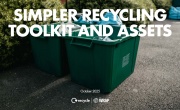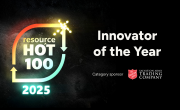An eye on the markets: Transparently circular
Rick Hindley, Executive Director of Alupro, provides the lowdown on the markets for recycled aluminium packaging
According to figures released in March by the Environment Agency on the National Packaging Waste Database (NPWD), 116,670 tonnes of aluminium packaging were collected for recycling in the UK last year – a 17 per cent increase compared to 2018 figures (99,852) and more than 8,400 tonnes higher than the government’s packaging recycling targets.

Aluminium packaging collected through kerbside, bring and on-the-go systems increased by almost 21 per cent (from 74,595 to 89,974), while tonnage recovered from incinerator bottom ash also experienced a small uplift (from 25,546 to 26,696). Since 2010, the industry has experienced a continued increase in recycling rates – a considerable achievement.The latest data, to be finalised in April, suggests a further significant increase in both the recycling rates for all aluminium packaging and drinks cans specifically.
Despite a year of sustained growth, the integrity of the Packaging Recovery Note (PRN) system, specifically with regard to aluminium was challenged. Indeed, insight suggests that last year a significant number of PRNs were raised but were held back and not released to the market – resulting in artificially-inflated PRN prices peaking at one point at more than £500 per tonne.
The latest NPWD data supports this view, reporting a surplus of 8,409 tonnes, leading to a carry forward of 7,746 tonnes towards next year’s targets (64 per cent in 2020 compared to 61 per cent in 2019). While hugely positive news, this is simply not reflected in such abnormally high PRN prices – a dichotomy which undermines aluminium’s sustainability credentials and could potentially influence commercial decisions made by packaging specifiers, who could understandably be challenged by the rising cost of compliance.
Such skewed prices have also driven a 41 per cent increase in the tonnage of aluminium packaging sent for export (75,541 in 2019, compared to 53,492 in 2018), while domestic market volumes have decreased by 11 per cent (41,129 in 2019 compared to 46,360 in 2018).
Holding back PRNs in order to raise prices artificially undermines the credibility of aluminium as a material with positive recycling properties and indeed the integrity of the PRN system.
 This article was taken from Issue 99
This article was taken from Issue 99If there were greater transparency in packaging waste recycling, there could be far more accountability to ensure that all money generated from PRNs is going towards strengthening collection and reprocessing infrastructure and funding behaviour change programmes. We are eager to see what additional investment to support further improvements in collection and recycling will result from the increased revenues received by some aluminium recyclers and exporters last year.
Alupro is fully aligned with the packaging sector’s calls for a compliance fee, which could offer obligated businesses an alternative route to compliance while PRN reforms are pending. In addition, a joint industry letter was sent to the Department for Environment, Food and Rural Affairs (Defra) in December, highlighting concerns shared across the retail sector, food and drink manufacturing sector and packaging manufacturers about the implications of enormous PRN price increases.
On the positive side, the inflated aluminium PRN price did result in a number of reprocessors and exporters becoming accredited for the first time, meaning that material that previously hadn’t been officially counted will now be included in the recycling rate calculation.
The recently published data suggests that the 2020 aluminium packaging recycling target should once again be surpassed. Therefore, under ‘normal’ market conditions, we would anticipate that PRN prices should begin to fall and return to a more realistic and sustainable level. But, of course, only time will tell.
In the short-term, encouraging greater transparency is key. In the long-term, however, a collaborative approach to PRN reform is essential.






